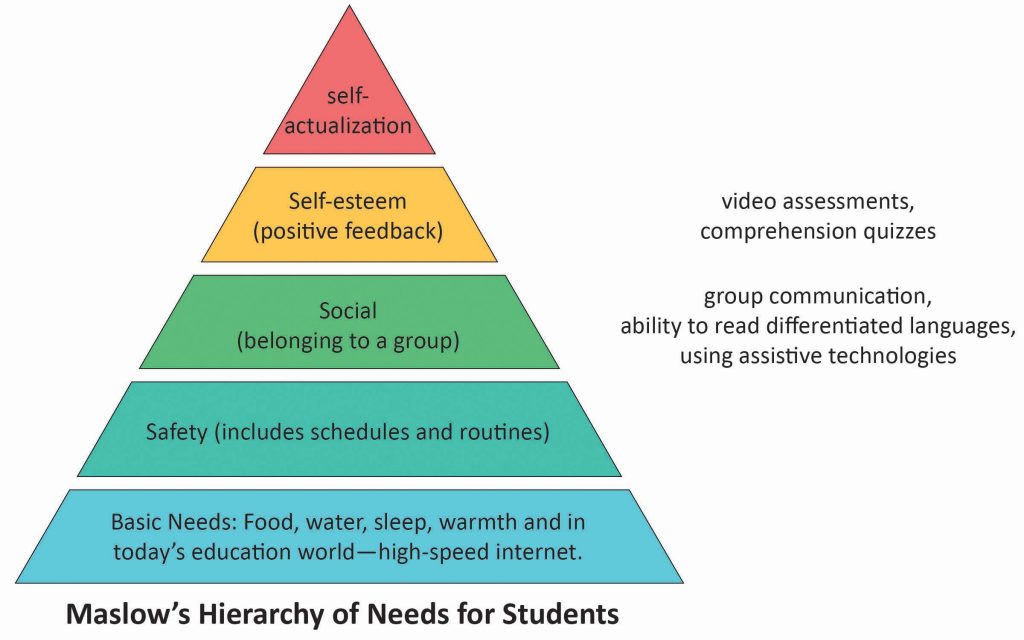As schools across the country are once again facing difficulties with COVID including staff shortages, sickness, and even school closures; it is a good time to remind ourselves of the many needs children have and how we can address those needs. Maslow’s Hierarchy of Needs reminds us of the critical needs our children must meet before they can be successful in the academic world. The foundational levels of the pyramid include basic needs and safety, which become much harder for schools to assist with in the middle of a pandemic, especially for our economically disadvantaged students.
The bottom, or first level, according to Maslow, applies to physical needs: food, water, sleep, and warmth (shelter). This is extremely difficult for districts to help students when buildings are closed. In-school learning allows for free and reduced lunches to help with hunger issues. Some educators may even help students with clothing. When school buildings are closed, some districts use school buses or even school resource or police officers to deliver food to students in need. It could be argued here that another basic need for students in today’s pandemic world is having access to fast internet. This is a concern for district administrators working with economically disadvantaged students, whether in urban or rural areas. When schools first shut down, some districts set up hot spots for their students to be able to gain access to the internet but that’s not really a long-term fix.
The second level is safety. Students who feel unsafe at home (for a host of reasons) or at school (bullying) will struggle to learn. Again, this is particularly difficult for schools to help students when buildings are closed. Having a relationship with the family can help educators, counselors and social workers help and support students. Interestingly, schedules and routines (whether in the building or online) help students feel safe as they know what to expect and when.
When students are worried about their physical and safety needs, they can’t focus on learning. Their lives are all about surviving. Substantial amounts of money have been set aside to help districts fund supporting students’ basic and safety needs. Using an excerpt from District Administration’s Side-by-side ESSER, ESSER II and ARB ESSER Allowable Activities Chart, here’s a quick look at funding opportunities available to districts to support students’ basic and safety needs:
| ESSER (CARES Act) | ESSER II (CRRSA Act) | ARP ESSER (ARP Act) |
| Activities that address unique needs of low-income children or students, children with disabilities, English learners, racial and ethnic minorities, students experiencing homelessness, and foster care youths, including how outreach and service delivery will meet the needs of each population. CARES Act Section 18003(d)(4). | Activities that address unique needs of low-income children or students, children with disabilities, English learners, racial and ethnic minorities, students experiencing homelessness, and foster care youths, including how outreach and service delivery will meet the needs of each population. CRRSA Act Section 313(d)(4). | Activities that address unique needs of low-income children or students, children with disabilities, English learners, racial and ethnic minorities, students experiencing homelessness, and foster care youths, including how outreach and service delivery will meet the needs of each population. ARP Act Section 2001(e)(2)(F). |
| Planning and coordination during long-term closures, including how to provide meals to eligible students, how to provide online learning technology to all students, how to provide guidance on meeting IDEA requirements, and how to ensure other educational services can continue to be provided consistent with federal, state, and local requirements. CARES Act Section 18003(d)(8). | Planning and coordination during long-term closures, including how to provide meals to eligible students, how to provide online learning technology to all students, how to provide guidance on meeting IDEA requirements, and how to ensure other educational services can continue to be provided consistent with federal, state, and local requirements. CRRSA Act Section 313(d)(8). | Planning and coordination during long-term closures, including how to provide meals to eligible students, how to provide online learning technology to all students, how to provide guidance on meeting IDEA requirements, and how to ensure other educational services can continue to be provided consistent with federal, state, and local requirements. ARP Act Section 2001(e)(2)(J). |
| Purchasing educational technology, which could include hardware, software, and connectivity, for students served by the LEA that aids in regular, substantive educational interaction between students and educators, including low-income students and students with disabilities. This could also include assistive technology or adaptive equipment. CARES Act Section 18003(d)(9). | Purchasing educational technology, which could include hardware, software, and connectivity, for students served by the LEA that aids in regular, substantive educational interaction between students and educators, including low-income students and students with disabilities. This could also include assistive technology or adaptive equipment. CRRSA Act Section 313(d)(9). | Purchasing educational technology, which could include hardware, software, and connectivity, for students served by the LEA that aids in regular, substantive educational interaction between students and educators, including low-income students and students with disabilities. This could also include assistive technology or adaptive equipment. ARP Act Section 2001(e)(2)(K). |
| Providing mental health services and supports. CARES Act Section 18003(d)(10). | Providing mental health services and supports. CRRSA Act Section 313(d)(10). | Providing mental health services and supports. ARP Act Section 2001(e)(2)(L). |
The third level of the hierarchy of needs is social which includes things like friendships, family, social and community groups, and religious organizations. In school, a student may have friends and join clubs or groups but when learning online, these same students may feel isolated and alone. It’s important for students to be able to communicate with their peers and teachers, even if through online chat rooms. Students need to feel accepted and part of a group.
The fourth level, self-esteem, includes the need to be appreciated and respected. Positive feedback gives students confidence to continue to learn.
And the fifth, or highest level, is self-actualization where students set and meet their own goals. They are using their full talents and potentials and are leading and succeeding at this level.
Fathom’s multilingual reading platform helps students at levels three and four. Whether reading a book in English, Spanish, or any of the other languages available, ESL and dual-language students are reading the same book, just in a differentiated manner. Because the underlying books (from 12 different award-winning publishers) introduce or supplement core-subjects being taught, students are exposed to strong academic vocabulary in a variety of languages. Interestingly, even though a student may speak Spanish at home, they still need to learn the academic vocabulary in both English and Spanish just as English speakers need to learn the academic vocabulary in English. Regardless of what language the student is reading and listening to (or using the bilingual feature), they are learning the same subject matter. Even reluctant or struggling English readers can use the assistive technology to read at the same level as their classmates. This helps students “fit in” to the classroom group.
In the early days of school closures, teachers (especially elementary school teachers) were begging for a way to read a book to their students so that all students could see. Fathom allows teachers to read a book online to their classroom and each student’s book is synchronized to the teacher’s reading. And in a twist on that theme, students can videotape themselves reading a book and can share the video with the teacher. Not only does that provide the teacher with a great way to assess student improvement over time, but it allows the students to see how far they’ve come in reading and language pronunciation, helping their self-esteem (level 2).
Since we’ve discussed a few ways that Fathom’s multilingual reading platform can help students succeed, what about helping teachers cope with all they do? Fathom includes a complete Learning Management System (LMS) with dashboards for school administrators and teachers along with individual student dashboards. Teachers can set up a virtual classroom with a bookshelf and student assignments, including comprehension quizzes pulled from an online database or they can make their own. Teachers can easily communicate with all students or individual students (there’s that level 3 communication need) through the LMS. Teachers can auto-populate their classrooms using ClassLink, Google Classroom, or with an excel sheet upload. With unlimited, simultaneous access to books, students may read at home or in the classroom so there’s no more need for classroom sets of physical books or having to purchase books in a variety of languages.
Seeing is believing. Go to https://www.fathomreads.com/#plans and request a 30-day free trial for schools. And the best part? ESSER, CARES and ARP funds can be used to subscribe to Fathom—see the technology section in the above chart.


